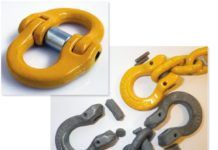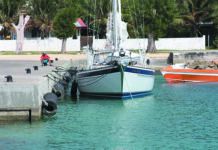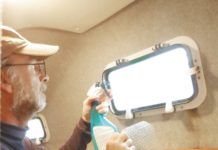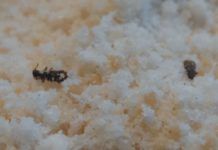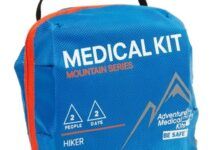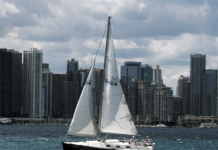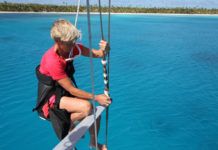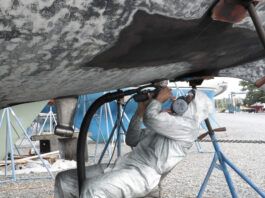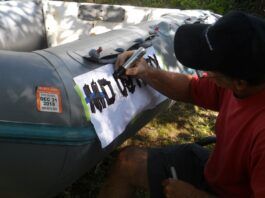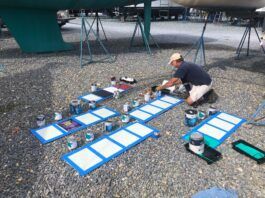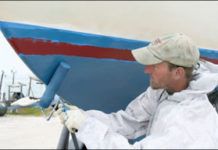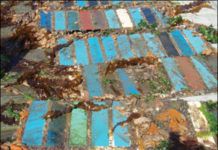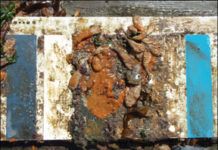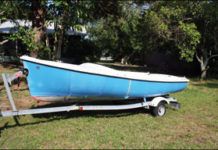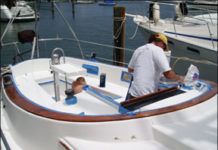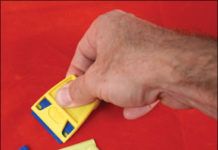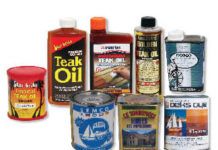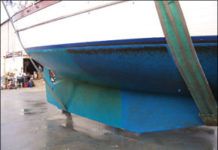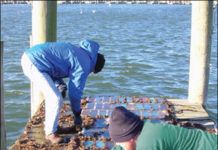Checking In With the Test-Boat Fleet
In addition to our annual paint-panel tests, Practical Sailor has a host of ongoing head-to-head field tests of the top-performing antifouling paints. Our test-boat fleet allows us to evaluate paints in real-world conditions on boats that run the gamut in terms of usage, storage, and cruising grounds. For the head-to-head tests, each boat’s hull below the waterline is divided into four equal sections (two per side). One paint is applied to the port bow and starboard aft section, while another is painted onto the starboard bow and port after section, giving both paints equal exposure. Paints are applied following maker’s instructions, and an extra coat is applied at the waterline.
Last Call for Top-Rated Bottom Paints After Two Years
Our two-year test wraps up with 20 top-rated paints. Unlike the last two-year results when hard paints dominated, the group is split with 10 self-polishing or ablative paints and 10 hard paints. Our Recommended, Best Choice, and Budget Buy picks also are divided pretty evenly. In past rating cycles for this panel set (October 2007 and March 2008), Interlux Micron 66 and Sea Hawk Biocop TF were named top picks. These two still lead the pack at the two-year mark. Both are expensive, with Micron 66 costing $220 per gallon and Biocop TF ringing in at $228 per gallon. They also both use zinc pyrithione as an anti-slime agent. Our top bright-color paint after two years in the water is Blue Water Kolor-another expensive paint, priced at $170 per gallon. The top-performing two-year paint suitable for race boats is Interluxs VC Offshore. Pettit Trinidad SR, well polished, would also be a good choice for racing.
Bottom Paint Test Report: Panels Rated at the One- and Two-year Marks
Looking for the best marine antifoulant to keep your hull clean? Check out Practical Sailors semi-annual bottom paint test report, which offers performance ratings on nearly 80 marine antifouling paints. Multiple sets of submerged fiberglass test panels-two in the Florida Keys and two in Long Island Sound-were pulled and examined for their resistance to hard growth and soft growth. Detailed charts show the results of the one-year and two-year tests for ablative paints, hard paints, and specialty paints (white paints, eco-friendly paints, bright paints, water-based paints, and racing boat paints). After the ratings were logged, testers retired the two-year panels to make room for the 2008 bottom paints. This lineup-72 paints in all-includes several low-copper paints and no-copper paints, which are becoming increasingly popular as sailors look for viable alternatives to metal-based paints. Paint manufacturers and distributors participating in the test include Blue Water Marine Paint; Donovan Marine; Epaint Co.; Flexdel Aquagard; Interlux Yacht Finishes; Kop-Coat; Pettit; New Nautical Coatings; Seahawk Paints; West Marine; and Boaters World (Seabowld). Among the top-rated paints are Interlux Micron 66, Interlux Super Ablative, Pettit Ultima SR, Pettit Trinidad SR, Pettit Unepoxy Plus, Pettit Vivid, and Sea Hawk Biocop TF.
Practical Sailor Searches for The Best Gelcoat Restorer
Acrylic fiberglass coatings are a practical alternative to use on your sailboat’s gel coat when waxes and polishes won’t revive that gelcoat shine. Practical Sailor tested seven new acrylic hull restorers designed to get rid of oxidation: Higley Fiberglass Restorer, Klasse High-Gloss Sealant Glaze, NewGlass2 (NuGlass2), Poli Glow, Star brite Glass Cote, Vertglas, and Presto gelcoat rejuvenator. The top performers were easy to apply and left the old, porous hull with a mirror-like shine.
Painting Your Own Deck
My wife and I have owned our boat since 1985. We now keep it in the British Virgin Islands, where the Caribbean sun is tough on finished wood and fiberglass. The reason I am writing you is to get your true feeling about novices handpainting our decks. We want to keep the nonskid and the white border design we currently have. The decks were Awlgripped by the factory in 1992, but this has turned chalky and shows tremendous wear. Is it feasible to try such a project? Or should I just pony up the money to have it done? We have time and plenty of elbow grease and a willingness to try.
Topside Paint Test Kicks Off with a Look at Application and Gloss, Tips and...
Practical Sailor applied 29 topside fiberglass paints from nine manufacturers to fiberglass panels and rated them on handling, coverage, and gloss. Paints will be evaluated for long-term durability and gloss retention over time. Seven of the paints are alkyd enamels; 12 are one-part urethanes; and eight are two-part linear polyurethanes. Two paints were classified as "other." Paints tested included alkyd enamels from Kirby, Sherwin-Williams, and Pettit Z-Spar; one-part urethanes from Epifanes, Insignia, Interlux, Pettit, and West Marine; and two-part polyurethanes from Epifanes, Awlgrip, Fabula, Insignia, Interlux, and Sherwin-Williams. Two Crab Coat paints from CrystaLac also were tested. Looking for tips on painting topsides yourself? PS also takes a look at the tips, tools, and techniques of do-it-yourself topside painting.
Plastic Razor Blades
Plastic scrapers have been around for a while. They are popular among painters, woodworkers, and auto detailers. For boaters, they make sense for jobs that need to be done quickly without scratching a delicate surface. However, for a fine cut and a lasting edge, metal blades remain the best choice. We tested the new ScrapeRite plastic razor blades on a variety of surfaces and found them handy for removing vinyl, cleaning dried paint on varnished wood, and trimming sealant. The blades come in three levels of hardness: red, general purpose blades for delicate surfaces like paint or varnish; blue, a polycarbonate blade for use on fiberglass and gelcoat; and yellow, acrylic blades for use on hard flat surfaces.
Practical Sailors Exterior Wood Coatings Test Continues
Most of us have a soft spot for a boat with fresh, beautiful brightwork on a teak deck-unless its your boat. Than the brightwork is just that: work-something that is synonymous with boat maintenance. In this, our fourth installment in our ongoing look at exterior wood finishes, Practical Sailor focuses on the application of teak oils and sealers. Testers evaluated eight products for ease of preparation, ease of application, number of coats recommended, recoat time, and finish. The products were: Dalys Seafin Teak Oil, Deks Olje No.1, Interlux Premium Teak Oil, Le Tonkinois Huiles Bio Impression, MDR Amazons Golden Teak Oil, Semco Teak Sealer, Star brite Premium Golden Teak Oil, and Star brite Tropical Teak Sealer. The Interlux Premium Teak Oil and Semco ranked as the top easy-to-apply teak oils. The inexpensive Star brites Premium Golden Teak Oil got the Budget Buy nod. Ratings were for initial results only as we wait for results from the second part of the evaluation, the durability test, for the final rankings. Long-term test may find that the more difficult a product is to apply, the longer it lasts. Also included in the search for a long-lasting wood finish are dozens of one-part varnishes, two-part varnishes, synthetic wood coatings, and wood stains. Stay tuned to see which products make the all-star list of the best wood finishes.
The State of the Union: Clean After 17 Months
In July 2006, Practical Sailor testers began a long-term bottom paint comparison between Interlux Micron Optima and Sea Hawk Monterey, two semi-hard ablative paints that are self-polishing, meaning that water movement during normal sailing cleans growth that may be trying to gain a foothold on the hull. The test platform is a Norfolk, Va.-based Union 36, a full keel, heavy displacement sailboat whose cruising area is primarily the Chesapeake Bay and Intracoastal Waterway in Virginia and North Carolina. The boats hull, below the waterline, was divided into four equal sections, giving both bottom paints equal exposure: Sea Hawk was applied to the starboard bow and port aft section, while Micron Optima was applied to the port bow and starboard aft sections. Each section received three coats of its respective bottom paint, plus an additional coat at the waterline. Since its launch in July 2006, the test boat has seen normal use, ranging from monthly weekend and day trips to several weeklong cruises.
Bottom Paint Test: Practical Sailor Takes a Close Look at The Long-Term Performance of...
Testing of hard and soft bottom paint in a Florida saltwater canal and a boatyard dock in Long Island Sound show that nearly all existing antifouling paints provide exceptional protection against hard growth for one season. The devil is in the detail of how well the paints hold up against the build-up of soft marine organisms, and for how long they will ward off barnacles. Although almost all of the paints Practical Sailor tested rated fair or good after 6 months, only one paint was rated excellent: Ablative/copolymer Micron 66 from Interlux. Although no paints garnered an excellent rating at18-months, Practical Sailor found several paints that continued to perform fairly well. Manufacturers try to provide protection against hard and soft growth while balancing environmental impact, regulatory concerns and rising prices in raw materials. Practical Sailor also rated the test paints by category: not only hard and soft paints, but also eco-friendly and water-based paints and looked at the performance of paints within each category.Products tested include: Micron 66, Copper Shield, EP 2000, Epaint, Epoxycop, Fiberglass Bottomkote, Ultra-Coat, Super KL, VC Offshore, Regatta Baltoplate Racing, Interlux Ultra, VC 17m Extra, Pettit Unepoxy Plus, Super Premium, Vivid, Trinidad, SR-21, Seahawk Tropikote, Tropikote Biocode Plus, Sharkskin, Bluewater Kolor, Epaint Zo, Flexdel Aquaguard Bottom Paint, Aquaguard Alumi-Koat, Super Ship Bottom, Epoxycop Ablative, Micron CSC, Trilux, Phasecoat, Hydrocoat, Horizons, Alumacoat, Ultima SR, Monterey, Mission Bay CSF, AF 33, Biocop, Cukote, Interlux, Pettit, Blue Water MarPro, Seahawk, and West Marine.











